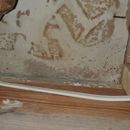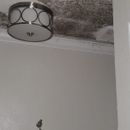Mold in a beach house. Moisture condensing on drywall?
I have a question about a house I was asked to look at by a client any thoughts/theories/solutions as to what’s going on would be awesome. I am a mechanical contractor in Houston.
The house is located on the beach on Galveston Island and has some significant mold growth on the ceilings over the toilets and around outlets on the exterior walls. Its unoccupied most of the year as it’s a vacation home. The upstairs thermostat was set to 77 f and the downstairs to 75 f with 73% RH upstairs.
In the attic there’s R-19 Kraft faced fiberglass batts, facer side down to the ceiling drywall. When you peel the batts up anywhere in the attic, the paper facer is damp and the drywall has damp spots on it. In some areas the ceiling joists down near the drywall have mold growing on them, but not everywhere. The attic is ventilated with soffit and ridge vent.
I’ve never seen anything like it before but I have to imagine many of the other houses down there are in similar shape. I also wonder how bad the mold inside the walls is.
My theory is that at some points of the day the backside of the drywall is below the dew point of the attic air causing moisture to condense onto the drywall and insulation facer, and that the inward drying potential caused by the air conditioner is insufficient to keep the drywall from growing mold especially over the toilets where the moisture load tips it over the edge and it starts to grow mold. The air conditioner is most likely also oversized especially at a 77 f setpoint which isn’t helping.
The solution to me seems to be to fully remediate the mold by removing the wall and ceiling drywall, removing the fiberglass insulation from the walls and treating the framing. After which install closed cell spray foam on walls and underneath side of the roof sheathing creating a conditioned attic. Then install a whole home dehumidifier to control humidity.
GBA Detail Library
A collection of one thousand construction details organized by climate and house part











Replies
When the house is unoccupied, it should be dehumidified but not cooled. 60% RH is fine and saves energy.
The warm side should have an air barrier and a vapor retarder. Spray foam is one way to do that.
Improving air sealing will help too.
^What Jon said. A/C likely doesn't run enough to dehumidify. A standalone dehumidifier is needed. Also check moisture sources: is the foundation in good shape? Does the bath fan vent into the attic, or up and out the roof as it should? Do occupants even use it during showers?
Your insulation is in backwards. The kraft paper should face the warm, humid side, which in your climate is the exterior. In a cooling dominated climate the house should be vapor open to the interior and vapor closed to the exterior.
I don't know if reversing the insulation is going to be enough by itself to solve the problem. You kind of have to built that way.
Just looking at weather.gov, the dewpoint today is 76F on Galveston Island. If your setpoint is 77F there are going to be places that are cooler. If exterior air can infiltrate to those places condensation will happen. The exterior needs to have a vapor barrier and be air sealed.
I disagree with dehumidified but not cooled. I'd go with both. Dehumidifiers are potent space heaters, the interior will get very hot, potentially to the point of damaging objects. Running a dehumidifier will get the AC to run more, which is what you want. You want RH below 50%.
But that's just a bandaid. If you have a wrong-side vapor barrier, lowering the interior humidity doesn't help much to prevent condensation inside the walls.